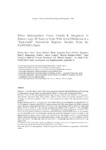Direct Anticoagulants Versus Vitamin K Antagonists in Patients Aged 80 Years or Older With Atrial Fibrillation in a “Real-world” Nationwide Registry: Insights From the FANTASIIA Study

Ver/
Use este enlace para citar
http://hdl.handle.net/2183/25597Coleccións
- Investigación (FEP) [507]
Metadatos
Mostrar o rexistro completo do ítemTítulo
Direct Anticoagulants Versus Vitamin K Antagonists in Patients Aged 80 Years or Older With Atrial Fibrillation in a “Real-world” Nationwide Registry: Insights From the FANTASIIA StudyAutor(es)
Data
2020-03-31Cita bibliográfica
Ortiz MR, Muñiz J, Esteve-Pastor MA, Marín F, Roldán I, Cequier A, Martínez-Sellés M, Saldivar HG, Bertomeu V, Anguita M. Direct Anticoagulants Versus Vitamin K Antagonists in Patients Aged 80 Years or Older With Atrial Fibrillation in a "Real-world" Nationwide Registry: Insights From the FANTASIIA Study. J Cardiovasc Pharmacol Ther. 2020 Jul;25(4):316-323.
Resumo
[Abstract]
Objective:
To describe major events at follow up in octogenarian patients with atrial fibrillation (AF) according to anticoagulant treatment: direct oral anticoagulants (DOACs) versus vitamin K antagonists (VKAs).
Methods:
A total of 578 anticoagulated patients aged ≥80 years with AF were included in a prospective, observational, multicenter study. Basal features, embolic events (stroke and systemic embolism), severe bleedings, and all-cause mortality at follow up were investigated according to the anticoagulant treatment received.
Results:
Mean age was 84.0 ± 3.4 years, 56% were women. Direct oral anticoagulants were prescribed to 123 (21.3%) patients. Compared with 455 (78.7%) patients treated with VKAs, those treated with DOACs presented a lower frequency of permanent AF (52.9% vs 61.6%, P = .01), cancer history (4.9% vs 10.9%, P = .046), renal failure (21.1% vs 32.2%, P = .02), and left ventricular dysfunction (2.4% vs 8.0%, P = .03); and higher frequency of previous stroke (26.0% vs 16.6%, P = .02) and previous major bleeding (8.1% vs 3.6%, P = .03). There were no significant differences in Charlson, CHA2DS2VASc, nor HAS-BLED scores. At 3-year follow up, rates of embolic events, severe bleedings, and all-cause death (per 100 patients-year) were similar in both groups (DOACs vs VKAs): 0.34 vs 1.35 (P = .15), 3.45 vs 4.41 (P = .48), and 8.2 vs 11.0 (P = .18), respectively, without significant differences after multivariate analysis (hazard ratio [HR]: 0.25, 95% confidence interval [CI]: 0.03-1.93, P = .19; HR: 0.88, 95% CI: 0.44-1.76, P = .72 and HR: 0.84, 95% CI: 0.53-1.33, P = .46, respectively).
Conclusion:
In this “real-world” registry, the differences in major events rates in octogenarians with AF were not statistically significant in those treated with DOACs versus VKAs.
Palabras chave
Direct oral anticoagulants
Vitamin K antagonists
Atrial fibrillation
Octogenarians
FANTASIIA registry
Vitamin K antagonists
Atrial fibrillation
Octogenarians
FANTASIIA registry
Versión do editor
ISSN
1940-4034





